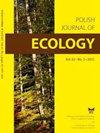Impact of Agriculture Intensification on the Floristic Diversity of the Forest-Field Ecotone
IF 0.7
4区 环境科学与生态学
Q4 ECOLOGY
引用次数: 2
Abstract
ABSTRACT The aim of the research was to study 20-year changes in the floristic richness of the vegetation and soil diaspore bank of agroceonoses and adjacent midfield woodlots, as a result of the intensification of agricultural production, and the role of the ecotone in the preservation of field weeds. The studies were conducted in two periods, the first between 1996 and 1998 and the second between 2016 and 2018, on 12 permanent plots located in a transition zone between agroceonoses and woodlots. The width of the ecotone zone was determined with a linear transect that crossed both communities. The study of vegetation was conducted using the Braun-Blanquet method. During each period, soil diaspore reserves were determined. A large decrease of approximately 30% in the number of species was noted in the agroceonoses, while there were minor changes in the wood communities. With only slight variation during the research, floristic diversity of the soil diaspore bank in those habitats was poorer than vegetation diversity. The ecotone phytoceonoses had the highest species richness. They showed greater floristic similarity to the wood phytoceonoses than to agroceonoses. In the transition zone a clear boundary was observed, dividing those two communities. The ecotone was a refuge for field species, including rare and endangered ones. The species composition of the ecotone soil diaspore bank was poorer than the composition of the flora and showed greater similarity to the species diversity of the agroceonoses. Additionally, a significant relationship between species richness and habitat conditions was noted.农业集约化对林区生态带植物多样性的影响
摘要本研究的目的是研究农业生产集约化20年来农业园区和邻近中间林地植被和土壤一水硬铝石库的区系丰富度的变化,以及交错带在田间杂草保护中的作用。这项研究分两个时期进行,第一个时期在1996年至1998年,第二个时期在2016年至2018年,在12个位于农业区和林地过渡区的永久地块上进行。交错带的宽度是用穿过两个群落的线性样带确定的。植被研究采用Braun Blanquet方法。在每个时期,都确定了一水硬铝石的土壤储量。农业群落中的物种数量大幅减少了约30%,而木材群落中的变化较小。在研究过程中,这些栖息地土壤一水硬铝石库的区系多样性仅略有变化,而植被多样性较差。交错带植物群落的物种丰富度最高。它们与木材植物群落的区系相似性大于与农业群落的区属相似性。在过渡区观察到一个明显的边界,将这两个社区分隔开来。交错带是野外物种的避难所,包括稀有和濒危物种。交错带土壤一水硬铝石库的物种组成比植物区系的物种组成差,并且与农学家的物种多样性表现出更大的相似性。此外,还注意到物种丰富度与栖息地条件之间存在显著关系。
本文章由计算机程序翻译,如有差异,请以英文原文为准。
求助全文
约1分钟内获得全文
求助全文
来源期刊

Polish Journal of Ecology
环境科学-生态学
CiteScore
1.10
自引率
0.00%
发文量
9
审稿时长
18-36 weeks
期刊介绍:
POLISH JOURNAL OF ECOLOGY (formerly Ekologia polska) publishes original scientific research papers dealing with all aspects of ecology: both fundamental and applied, physiological ecology, evolutionary ecology, ecology of population, community, ecosystem, landscape as well as global ecology. There is no bias regarding taxons, ecosystems or geographical regions.
 求助内容:
求助内容: 应助结果提醒方式:
应助结果提醒方式:


